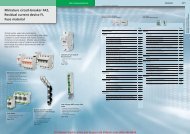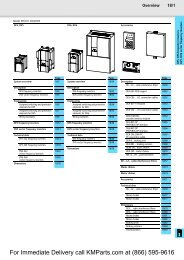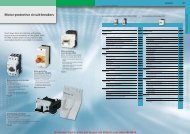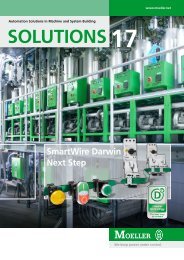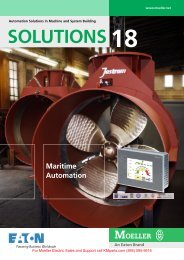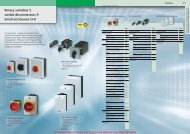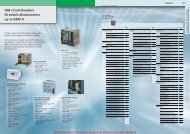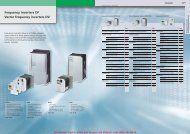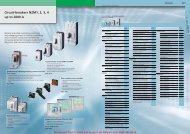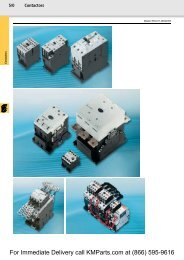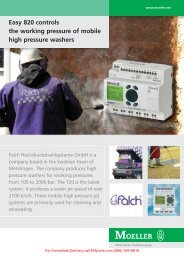Approvals and certificates - Moeller Electric Parts
Approvals and certificates - Moeller Electric Parts
Approvals and certificates - Moeller Electric Parts
You also want an ePaper? Increase the reach of your titles
YUMPU automatically turns print PDFs into web optimized ePapers that Google loves.
For <strong>Moeller</strong> <strong>Electric</strong> Sales <strong>and</strong> Support call KMparts.com (866) 595-9616<br />
http://catalog.moeller.net<br />
<strong>Moeller</strong> HPL0211-2007/2008<br />
P 1 <strong>and</strong> P 3 can be used as main switches in motor<br />
circuits <strong>and</strong> in controllers. The required line fuses are<br />
detailed on the devices’ ratings plates.<br />
N switch-disconnectors<br />
In North America, these devices are industrial control<br />
equipment to UL 508 <strong>and</strong> CSA-C 22.2 No. 14) <strong>and</strong> are<br />
used mainly in controllers <strong>and</strong> motor control centres<br />
(MCC). They are rated in HP, their rated current is given<br />
in A <strong>and</strong> – if they are equipped with auxiliary contacts<br />
– they contain duty type information (pilot duties,<br />
a Page A1/16).<br />
The devices can be used for switching motor circuits<br />
<strong>and</strong> other main circuits, <strong>and</strong> their auxiliary contacts for<br />
switching control circuits.<br />
N switch-disconnectors require an upstream shortcircuit<br />
protection device.<br />
In main current outgoing <strong>and</strong> incoming lines, both<br />
devices can be used as main switches.<br />
Fuse bases <strong>and</strong> fuses<br />
1) Avoid the use of fuses by using fuseless devices,<br />
such as motor-protective circuit-breakers,<br />
observing the selection criteria (a Page A1/17).<br />
The reasons for this are as follows:<br />
a) Fuse bases for North American fuses are very<br />
large <strong>and</strong> take up a lot of space.<br />
b) NZM circuit-breakers provide current isolation,<br />
short-circuit protection <strong>and</strong> overload protection<br />
in a single device <strong>and</strong> are much less expensive<br />
<strong>and</strong> smaller than a combination of fuse base,<br />
fuses <strong>and</strong> overload relay.<br />
c) In the USA <strong>and</strong> in Canada, many different fuse<br />
systems are in use. For non-American vendors, it<br />
may be almost impossible to find out the fuse<br />
system used by the end customer (who may not<br />
be known at all to the vendor).<br />
d) The plant or machine becomes independent of<br />
the locally used fuse system.<br />
2) Because no replacement fuses are needed, spare<br />
parts management is simplified. If the use of fuses<br />
is unavoidable, we recommend that you observe the<br />
following points:<br />
a) North American fuses are classified according to<br />
physical size, switching capacity <strong>and</strong> current–<br />
time characteristics. The table on Seite 17/18<br />
(Enclosure protection types...) provides a rough<br />
overview. It is best, however, to always ask the<br />
end customer about the required fuse types.<br />
b) Motor circuits:<br />
Where slow fuses (“dual element time delay<br />
fuses” or “time delay fuses”) are used:<br />
Rated current of max. line fuse F 1.75 × rated<br />
motor current or next-higher fuse rated current<br />
(max. 2.25 ×rated motor current).<br />
Where fast fuses (“non-time delay fuses”) are<br />
used:<br />
Rated current of max. line fuse F 3 × rated<br />
motor current or next-higher rated fuse current<br />
(max. 4 × rated motor current).<br />
c) Circuits with non-motor loads: Select the line<br />
fuse specified by the manufacturer.<br />
d) Switchgear:<br />
For switchgear requiring line fuses for their own<br />
short-circuit protection, select fuses according<br />
to the information in the device’s technical data<br />
or on the ratings plate. For short-circuit<br />
protection of the combination of <strong>Moeller</strong><br />
contactor <strong>and</strong> overcurrent relay,<br />
see a Page A1/23 for the max. line fuses.<br />
To ensure both trouble-free motor starting <strong>and</strong> shortcircuit<br />
protection of all devices within a circuit, select<br />
the smallest fuse required according to criteria 2b), 2c)<br />
<strong>and</strong> 2d).<br />
Supplementary Protectors FAZ<br />
In North America, these devices are industrial control<br />
equipment <strong>and</strong> protectors (supplementary protectors<br />
according to UL 1077 <strong>and</strong> CSA-C22.2 No. 235). They<br />
are used mainly in controllers. They can also be used<br />
as additional protective device in electrical devices<br />
whose incomer is already short-circuit protected or<br />
does not need short-circuit protection.<br />
These devices’ rated current is given in A. They have<br />
non-adjustable magnetic short-circuit releases for<br />
short-circuit protection <strong>and</strong> fixed-current or adjustable<br />
overload relays for overload protection for non-motordriven<br />
outgoing circuits.<br />
They can be used as overload <strong>and</strong> short-circuit<br />
protection devices in single-phase control circuits with<br />
or without additional neutral pole. They must in<br />
addition be fitted with an upstream short-circuit<br />
protection device as per device specifications<br />
(technical data a Page A1/38).<br />
FAZ supplementary protectors are especially well<br />
suited for fuseless protection of control circuits on the<br />
secondary side of transformers whose primary side is<br />
already short-circuit protected or does not need shortcircuit<br />
protection.<br />
Auxiliary contacts, voltage releases<br />
For the practice common in Europe of making it<br />
possible for customers to retrofit devices with auxiliary<br />
contacts, undervoltage releases, shunt releases <strong>and</strong><br />
other accessories, the corresponding UL <strong>and</strong> CSA<br />
approvals can now be issued.<br />
The modular method makes it possible to extend the<br />
range of applications of contactors, circuit-breakers,<br />
the PKZ2 system <strong>and</strong> control circuit devices by fitting<br />
add-on modules. For detailed information, see the<br />
device data.<br />
Continuous currents <strong>and</strong> switching duties for auxiliary<br />
switches according to the tables for auxiliary switches<br />
on a Page A1/16 are assigned to the code<br />
designations <strong>and</strong> switching duty types indicated in the<br />
devices’ technical specifications <strong>and</strong> on their ratings<br />
plates. The auxiliary contacts of <strong>Moeller</strong> devices<br />
approved mainly for “heavy pilot duty”, <strong>and</strong> on some<br />
devices for “st<strong>and</strong>ard pilot duty”. For detailed<br />
information, see the technical data for the devices. The<br />
ratings plate for some auxiliary switches contains<br />
information such as “600 V, same polarity”. This<br />
means that adjacent auxiliary contacts of the same<br />
auxiliary switch or switch block must be connected<br />
only to the same control voltage source.<br />
Enclosures<br />
Requirements:<br />
1) In North America, enclosures are often classified<br />
<strong>and</strong> ordered by NEMA type, <strong>and</strong> in Canada by<br />
EEMAC type, even though the binding design,<br />
ingress protection, etc. requirements of enclosures<br />
are today contained in NEC NFPA 70, UL 508 <strong>and</strong><br />
UL 50 for the USA, <strong>and</strong> in CSA-22.2 No. 14 <strong>and</strong><br />
CSA-C 22.2 No. 94 for Canada.<br />
2) The enclosures used by <strong>Moeller</strong> are accepted for<br />
use in North America, since they are UL- <strong>and</strong> CSAapproved<br />
<strong>and</strong> meet the most important NEMA<br />
requirements regarding contact protection,<br />
corrosion protection <strong>and</strong> ingress protection against<br />
solids <strong>and</strong> liquids.<br />
Switchgear for North America<br />
Selection of devices<br />
A1/15<br />
3) To some extent, the requirement for NEMA types<br />
also covers design details, such as hinged doors or<br />
covers that can be opened <strong>and</strong> locks only with a<br />
tool, external fixing strips for wall-mounting<br />
enclosures, etc. To fulfill the NEMA requirement,<br />
consult <strong>Moeller</strong> about the intended application.<br />
4) Degrees of protection:<br />
The IEC st<strong>and</strong>ards define the ingress protection of<br />
enclosures against solids <strong>and</strong> water. The<br />
comparable st<strong>and</strong>ards in Canada <strong>and</strong> the USA go<br />
further, also covering protection against ingress of<br />
oil <strong>and</strong> coolant, <strong>and</strong> corrosion protection of the<br />
enclosure; they also define its place of<br />
installation. The table on a Page A1/18 provides<br />
an overview of the requirements in Canada <strong>and</strong><br />
the USA <strong>and</strong> a comparison with the IP ratings.<br />
5) Sheet steel enclosures:<br />
Sheet steel enclosures can be used for all types of<br />
controllers. In North America, cables are still laid<br />
mainly in metal conduits that act as continuous<br />
earth conductor at the same time. They are<br />
connected to the enclosure flanges with suitable<br />
metal screwed gl<strong>and</strong>s, while flanged enclosures<br />
ensure continuous conductivity between incoming<br />
<strong>and</strong> outgoing conduits. All enclosures used must<br />
therefore contain metal flanges, <strong>and</strong> are included<br />
in the protective earthing. Sheet steel enclosures<br />
with metal flanges are also suitable for connecting<br />
plastic conduits <strong>and</strong> cables, which are connected<br />
with commercial gl<strong>and</strong>s. In this configuration, an<br />
earth conductor routed with the cabling provides<br />
the protective earthing. The metal flanges can be<br />
taken off for drilling the holes for the gl<strong>and</strong>s.<br />
Insulated enclosures:<br />
The CI enclosures fulfill the North American<br />
statutory design <strong>and</strong> ingress protection<br />
requirements (laid out by UL 508 <strong>and</strong> NEMA 250<br />
for the USA, in CSA 22.2 No.14 for Canada), <strong>and</strong><br />
are therefore suitable for the assembly of motor<br />
starters <strong>and</strong> miniature <strong>and</strong> small control systems<br />
for plants <strong>and</strong> machines. Their absolute corrosion<br />
resistance makes them ideal for use in humid or<br />
corrosive environments. The enclosures are<br />
suitable for the connection of both metal conduits<br />
<strong>and</strong> plastic conduits <strong>and</strong> cables, which are<br />
connected with commercial screwed gl<strong>and</strong>s.<br />
Because “total insulation” is usually not<br />
recognized for insulated enclosures in the USA <strong>and</strong><br />
Canada, protective earthing must be implemented<br />
when these conduits <strong>and</strong> cables are connected to<br />
them. The earth conductor must be routed through<br />
the enclosures as described in the attached<br />
installation instructions.<br />
The CI-...-NA enclosures are approved both with<br />
<strong>and</strong> without insulated flanges. For a full selection<br />
of UL/CSA-approved CI enclosure types, contact<br />
your regional <strong>Moeller</strong> sales office. The table on<br />
a Page A1/18 provides an overview of ingress<br />
protection to NEC (National <strong>Electric</strong>al Code), UL,<br />
NEMA <strong>and</strong> CSA.<br />
<strong>Approvals</strong> for world markets



